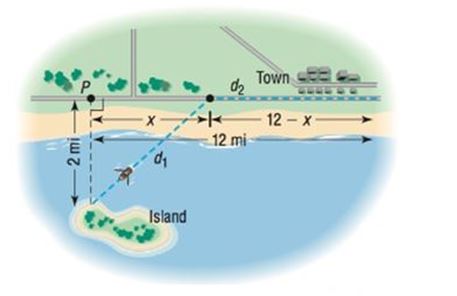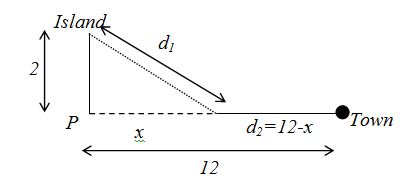
Concept explainers
23. Time Required to Go from an Island to a Town An island is 2 miles from the nearest point P on a straight shoreline. A town is 12 miles down the shore from P. See the illustration.

(a) If a person can row a boat at an average speed of 3 miles per hour and the same person can walk 5 miles per hour, build a model that expresses the time T that it takes to go from the island to town as a function of the distance X from P to where the person lands the boat.
(b) What is the domain of Τ?
(c) How long will it take to travel from the island to town if the person lands the boat 4 miles from P?
(d) How long will it take if the person lands the boat 8 miles from Ρ?
To find:
a. To model that expresses the time that it takes to go from the island to the town as a function of distance from .
Answer to Problem 23AYU
Solution:
a.
Explanation of Solution
Given:
1. The shortest distance from the island to shore is 2 miles (Point ).
2. The town is 12 miles from the point .
3. The person can row boat at 3 miles per hour.
4. The person can walk at 5 miles per hour.
Calculation:
The can be expressed as the figure below

Let be the distance from point where person lands in the shore.
Let be the distance the person row the boat.
Let be the distance the person walks.
Let be the average speed of the person when he rows the boat.
Let be the average speed of the person when he walks.
a. Let be the time taken to reach the town form the island.
Where,
To find:
b. To find the domain of .
Answer to Problem 23AYU
Solution:
b.
Explanation of Solution
Given:
1. The shortest distance from the island to shore is 2 miles (Point ).
2. The town is 12 miles from the point .
3. The person can row boat at 3 miles per hour.
4. The person can walk at 5 miles per hour.
Calculation:
The can be expressed as the figure below

Let be the distance from point where person lands in the shore.
Let be the distance the person row the boat.
Let be the distance the person walks.
Let be the average speed of the person when he rows the boat.
Let be the average speed of the person when he walks.
b.
To find:
c. To find time , if the person lands the boat 4 miles from .
Answer to Problem 23AYU
Solution:
c.
Explanation of Solution
Given:
1. The shortest distance from the island to shore is 2 miles (Point ).
2. The town is 12 miles from the point .
3. The person can row boat at 3 miles per hour.
4. The person can walk at 5 miles per hour.
Calculation:
The can be expressed as the figure below

Let be the distance from point where person lands in the shore.
Let be the distance the person row the boat.
Let be the distance the person walks.
Let be the average speed of the person when he rows the boat.
Let be the average speed of the person when he walks.
c. To find time , if the person lands the boat 4 miles from .
To find:
d. To find time , if the person lands the boat 8 miles from .
Answer to Problem 23AYU
Solution:
d.
Explanation of Solution
Given:
1. The shortest distance from the island to shore is 2 miles (Point ).
2. The town is 12 miles from the point .
3. The person can row boat at 3 miles per hour.
4. The person can walk at 5 miles per hour.
Calculation:
The can be expressed as the figure below

Let be the distance from point where person lands in the shore.
Let be the distance the person row the boat.
Let be the distance the person walks.
Let be the average speed of the person when he rows the boat.
Let be the average speed of the person when he walks.
d. To find time , if the person lands the boat 8 miles from .
.
Chapter 2 Solutions
Precalculus
Additional Math Textbook Solutions
A Problem Solving Approach To Mathematics For Elementary School Teachers (13th Edition)
Algebra and Trigonometry (6th Edition)
Elementary Statistics: Picturing the World (7th Edition)
Calculus: Early Transcendentals (2nd Edition)
Elementary Statistics
Calculus: Early Transcendentals (2nd Edition)
- ۳/۱ R₂ = X2 2) slots per pole per phase 3/31 B. 180 msl Kas Sin (I) 1sin() sin(30) Sin (30) اذا ميريد شرح الكتب بس 0 بالفراغ 3) Cos (30): 0.866 4) Rotating 5) Synchronous speeds 120×50 looo G 1000-950 1000 Copper losses 5kw Rotor input 5 loo kw 0.05 6) 1 اذا ميريد شرح الكتب فقط look 7) rotor DC ined sove in peaper I need a detailed solution on paper please 0 64 Find the general solution of the following equations: QI//y(4)-16y= 0. Find the general solution of the following equations: Q2ll yll-4y/ +13y=esinx.arrow_forwardR₂ = X2 2) slots per pole per phase = 3/31 B-180 60 msl kd Kas Sin () 2 I sin (6) sin(30) Sin (30) اذا مريد شرح الكتب بس 0 بالفراغ 3 Cos (30) 0.866 4) Rotating ined sove in peaper 5) Synchronous speed s 120×50 6 s = 1000-950 1000 Copper losses 5kw Rotor input 5 0.05 6) 1 loo kw اذا ميريد شرح الكتب فقط Look 7) rotov DC I need a detailed solution on paper please 0 64 Solve the following equations: 0 Q1// Find the solution of: ( y • with y(0) = 1. dx x²+y²arrow_forwardR₂ = X2 2) slots per pole per phase = 3/3 1 B-180-60 msl Ka Sin (1) Isin () sin(30) Sin (30) اذا ميريد شرح الكتب بس 0 بالفراغ 3) Cos (30) 0.866 4) Rotating 5) Synchronous speed, 120 x 50 s = 1000-950 1000 Copper losses 5kw Rotor input 5 6) 1 0.05 G 50105 loo kw اذا ميريد شرح الكتب فقط look 7) rotov DC ined sove in peaper I need a detailed solution on paper please 064 2- A hot ball (D=15 cm ) is cooled by forced air T.-30°C, the rate of heat transfer from the ball is 460.86 W. Take for the air -0.025 Wim °C and Nu=144.89, find the ball surface temperature a) 300 °C 16 b) 327 °C c) 376 °C d) None か = 750 01arrow_forward
- Don't do 14. Please solve 19arrow_forwardPlease solve 14 and 15arrow_forward1. Consider the following system of equations: x13x2 + 4x3 - 5x4 = 7 -2x13x2 + x3 - 6x4 = 7 x16x213x3 - 21x4 = 28 a) Solve the system. Write your solution in parametric and vector form. b) What is a geometric description of the solution. 7 c) Is v = 7 in the span of the set S= [28. 1 HE 3 -5 3 ·6 ? If it is, write v 6 as a linear combination of the vectors in S. Justify. d) How many solutions are there to the associated homogeneous system for the system above? Justify. e) Let A be the coefficient matrix from the system above. Find the set of all solutions to Ax = 0. f) Is there a solution to Ax=b for all b in R³? Justify.arrow_forward
- 4. Suppose that A is made up of 5 column vectors in R³, and suppose that the rank(A)=3. a. How many solutions are there to Ax=0? Justify. b. What is a geometric description for the nullspace(A)? Justify. c. Do the column vectors of A span R³? Justify. d. Is A invertible? Justify.arrow_forward3. Suppose that A is 5 x 5 and rank(A)=4. Use this information to answer the following. a. Give a geometric description of nullspace(A). Justify. b. Is A invertible? Justify. c. Give a geometric description of the span of the column vectors of A. What space are the column vectors of A in? Justify. d. What is determinant of A? Justify.arrow_forward2. Consider the matrix: A || 1 1 -3 14 2 1 01 4 1 2 2 -26 1 -3 1 5] a) What is rank(A)? b) Is A invertible? Justify. c) Find the nullspace(A). Justify. d) Is the trivial solution the only solution to Ax=0? Justify. e) What is the span of the column vectors of A? Justify.arrow_forward
- E 5. Suppose that S={v € R²: v = [2x² - 3]}. Is S a subspace of R²? Prove or disprovearrow_forward6. Suppose that V1, V2 ER", show that span{v1, v2} is a subspace of Rn.arrow_forwardRa X 2) slots per pole per phase 3/31 180 Ko Sin (1) Kdl 1 sin (4) sin(3) Sin (30) اذا مرید شرح الكتب بس 0 بالفراغ 3) Cos (30) 0.866 4) Rotating 5) Synchronous speed, 120 Fo lasa! G s.1000-950 20:05 1000 Capper losses: 5kw Rotor input lookw 0.05 ined sove in peaper I need a detailed solution on paper please 6) 1 ۳/۱ وه اذا ميريد شرح الكتب فقط look DC 7) rotov Find the general solution of the following equations: +4y=tan2x 3 7357 Find the general solution of the following equations: - Qll y + y (³) = 0. 101arrow_forward
 Calculus: Early TranscendentalsCalculusISBN:9781285741550Author:James StewartPublisher:Cengage Learning
Calculus: Early TranscendentalsCalculusISBN:9781285741550Author:James StewartPublisher:Cengage Learning Thomas' Calculus (14th Edition)CalculusISBN:9780134438986Author:Joel R. Hass, Christopher E. Heil, Maurice D. WeirPublisher:PEARSON
Thomas' Calculus (14th Edition)CalculusISBN:9780134438986Author:Joel R. Hass, Christopher E. Heil, Maurice D. WeirPublisher:PEARSON Calculus: Early Transcendentals (3rd Edition)CalculusISBN:9780134763644Author:William L. Briggs, Lyle Cochran, Bernard Gillett, Eric SchulzPublisher:PEARSON
Calculus: Early Transcendentals (3rd Edition)CalculusISBN:9780134763644Author:William L. Briggs, Lyle Cochran, Bernard Gillett, Eric SchulzPublisher:PEARSON Calculus: Early TranscendentalsCalculusISBN:9781319050740Author:Jon Rogawski, Colin Adams, Robert FranzosaPublisher:W. H. Freeman
Calculus: Early TranscendentalsCalculusISBN:9781319050740Author:Jon Rogawski, Colin Adams, Robert FranzosaPublisher:W. H. Freeman
 Calculus: Early Transcendental FunctionsCalculusISBN:9781337552516Author:Ron Larson, Bruce H. EdwardsPublisher:Cengage Learning
Calculus: Early Transcendental FunctionsCalculusISBN:9781337552516Author:Ron Larson, Bruce H. EdwardsPublisher:Cengage Learning





